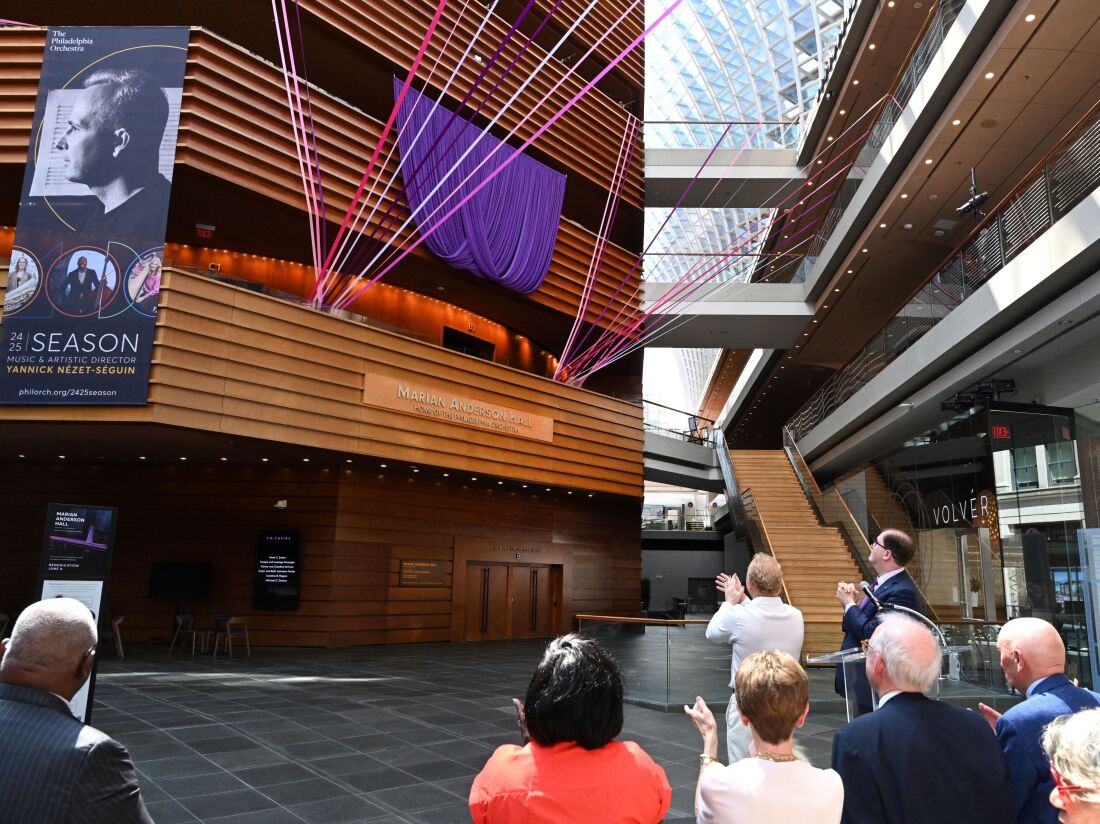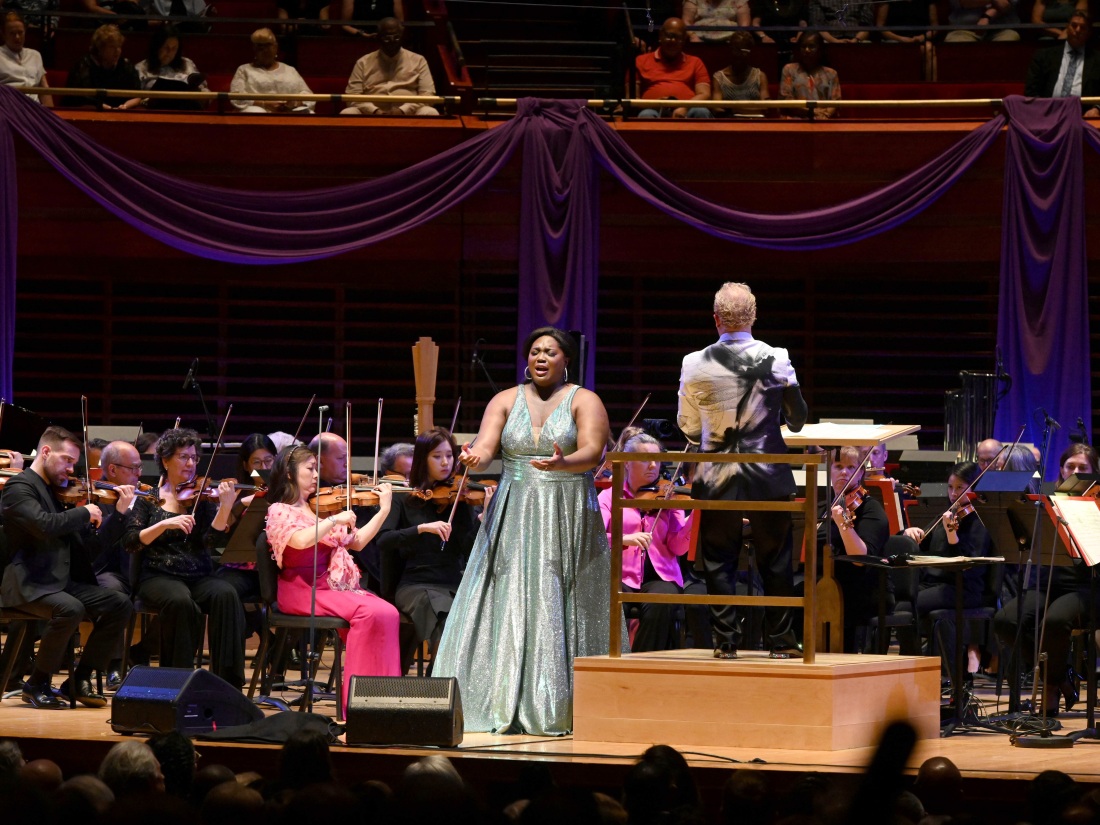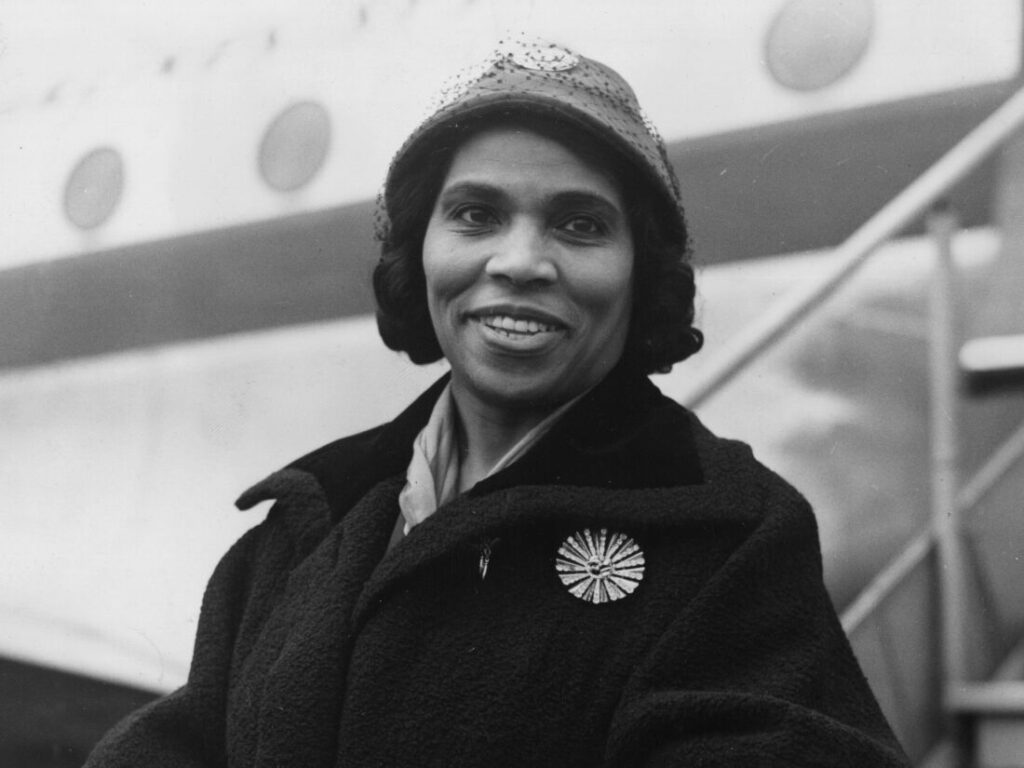Marian Anderson arrives in London in 1952. On June 8, the Philadelphia Orchestra named its main performance hall in her honor.
Douglas Miller/Getty Images
hide caption
toggle caption
Douglas Miller/Getty Images
History, we know, is always in the making — an aggregate of small actions, reactions and interactions, every flap of every butterfly’s wings. Yet most of the time, we have no idea what will come of any of it. Even when circumstances converge to highlight a transformative moment, there’s no seeing the flow of the future.
On April 9, 1939, the 42-year-old American contralto and international star Marian Anderson stepped onto a temporary stage on the steps of the Lincoln Memorial and began to sing. She opened with “My Country, ‘Tis of Thee,” a pointed choice given the events that had led to those first notes. Anderson had come to Washington at the invitation of Howard University, and the venerable Constitution Hall had been chosen as the venue for her much-anticipated appearance — until the Daughters of the American Revolution, who owned the hall, made clear that they would not allow a Black artist to perform on their stage. What the group did not count on was the dissent of one of their members, first lady Eleanor Roosevelt, who resigned from the DAR in protest and assisted in the effort to find an alternate venue, producing an event that would highlight the ongoing national struggle for racial equality. Where better than in the shadow of Abraham Lincoln himself?
As Anderson took that stage — in front of cameras, microphones and 75,000 people, plus a radio audience of millions — she had to know she was stepping into history. She later remembered, in her autobiography, “I could not run away from this situation. If I had anything to offer, I would have to do so now.” She was aware, certainly, that the events of that day would resonate at a national level, and I’m sure she hoped her actions would contribute to a fairer, more welcoming future for Black citizens and artists. But there was so much she couldn’t know.
She couldn’t foresee that she herself would break the color barrier, 16 years later on one of America’s most revered stages, as the first Black singer to perform at New York’s Metropolitan Opera. She couldn’t have imagined, that day in 1939, that a 10-year-old boy in Atlanta, who was listening to the radio broadcast of her performance, would grow up to lead a national movement for civil rights, and would ask her to return to those same Lincoln Memorial steps in August 1963 to sing at the March on Washington, where he would deliver his speech “I Have a Dream.”
And of course, on that April day, Marian Anderson could never have dreamed that the renowned Philadelphia Orchestra, with whom she had made her hometown debut just two years earlier, would rename its future concert hall in her honor. The date of that dedication, June 8, 2024, has now been declared Marian Anderson Day in the state of Pennsylvania. It’s a profound statement, a decree that this leading American cultural space is intended to be one of global welcome, a place to celebrate what Dr. King called “the beautiful symphony of brotherhood.”

Spectators applaud the unveiling of the newly-named Marian Anderson Hall in Philadelphia.
Pete Checchia/Philadelphia Orchestra
hide caption
toggle caption
Pete Checchia/Philadelphia Orchestra
I was at that June 8 ceremony. As I listened to an emotional tribute from Cherelle Parker, Philadelphia’s 100th mayor and the first Black woman to hold that office, I suddenly realized the biggest, most important thing that Anderson didn’t know back in 1939. She didn’t know about us — all of us here and now, doing what we do, breaking new barriers and reaching new heights, supported by the strength we’ve found in her legacy of courage.
Anderson is one of what I call my fairy godmothers, the Black and brown women in music history who have watched over and inspired me as I’ve built the dream, and then the reality, of my life in music. It’s not an overstatement to say that without them I wouldn’t be who I am, doing what I do. Queen Latifah said much the same thing that evening in Philadelphia, as the host of a gala concert to inaugurate the newly named Marian Anderson Hall. She spoke of herself and the other musicians sharing the stage — Broadway legend Audra McDonald, jazz pianist Marcus Roberts and opera singers Angel Blue and Latonia Moore — as members of a community of American artists whose dreams and careers have been built on the foundation of Anderson’s legacy.

Soprano Angel Blue (center) performs with conductor Yannick Nézet-Séguin and the Philadelphia Orchestra during a concert celebrating the renaming of the orchestra’s main performance space as Marian Anderson Hall
Pete Checchia/Philadelphia Orchestra
hide caption
toggle caption
Pete Checchia/Philadelphia Orchestra
We all felt the truth of that bond when Blue broke down in tears of gratitude as she sang the last notes of the aria “Vissi d’arte” (“I lived for art”) from Puccini’s Tosca. My own tears came when the orchestra played music by Florence Price — a colleague and friend of Anderson’s, and a composer who took her own place in the history books in 1933, when the Chicago Symphony Orchestra’s premiere of her Symphony in E minor made her the first Black woman ever to have her music performed by a major American orchestra. I thought about the strength of that sisterhood, how it has rippled into the present day and even into my life and career, as Price’s music has been a conduit to my own treasured relationship with the Philadelphia Orchestra. I will play her Piano Concerto with them next spring, for the second time.
Marian Anderson died in 1993, at the age of 96. She witnessed tremendous progress during almost a century of American history, as well as plenty of tragedy, upheaval and injustice. In my eyes, iconic moments like the Lincoln Memorial concert — the ones that are captured on tape and film to become permanently etched in our cultural consciousness — assume an unfair burden, the idea that a moment can change everything. History is not linear, and progress is not irreversible. At every moment there are billions of butterflies flapping their wings, creating conflicting cross-currents of change. Today, 85 years after Marian Anderson stood up for racial equality, we’re still struggling for equal rights, and even witnessing a reversal of some of the forward movement that was achieved during her lifetime. There is as much need for courage and hope as there ever was.
Still, I suppose that every time you send your hope and courage out into the world, on the wings of a thought or a song, you become some small part of history, of an unknown future. Come next spring, before I step onto the stage of Marian Anderson Hall, I’ll be sure to take a moment to touch her photograph in the wings. I’ll think of everything she couldn’t know in 1939, and everything we can’t know now. And then I’ll walk out into the lights to join my fellow musicians, trusting only that our music will float off in the currents of history, traveling far away to a someday that we can’t even begin to imagine.


